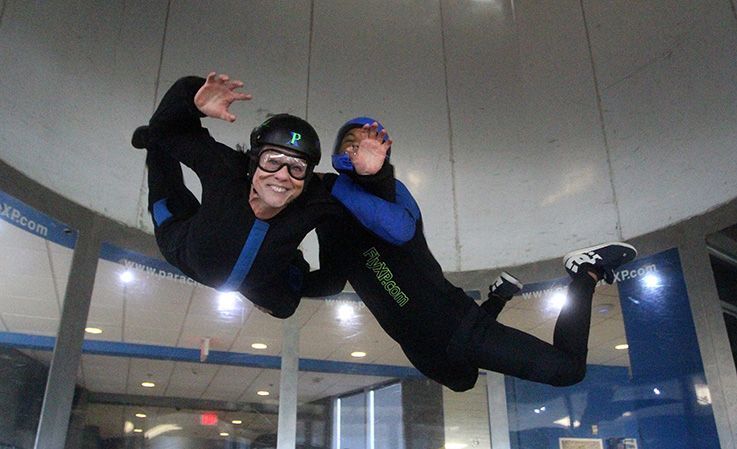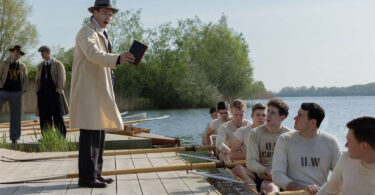Caroline Gilmore
Above: Caroline Gilmore in flight with instructor Manny Black at Paraclete XP, April 2019. PHOTO COURTESY CAMERON McMAHON, Paraclete XP
Years ago, I decided to jump out of a perfectly good airplane on a tandem skydive. While the experience wasn’t disastrous, it was traumatic (see sidebar). Fast forward almost 18 years, I decided to try to recapture the great feeling I had when I was free falling while outdoor skydiving by doing indoor skydiving.
The closest indoor skydiving facility is Paraclete XP SkyVenture (Paraclete XP; www .paracletexp.com) which is 30 minutes due west of Fayetteville in Raeford.
In operation since 2008, Paraclete XP is open seven days a week, and boasts the largest indoor skydiving vertical wind tunnel in the United States in terms of power and size. Their climate-controlled wind tunnel is 16.5 feet in diameter and 56 feet tall from the wire net grid at the bottom of the flight chamber to the top of the wind tunnel where the fans are, and is powered by four huge fans with 541 horsepower each (2,164 total horsepower).
Because of this extraordinary wind tunnel, Paraclete XP routinely hosts flyers from Fayetteville, Raleigh, Durham, Charlotte, all over South Carolina and Georgia year-round. Lots of inexperienced flyers come to Paraclete XP, but experienced skydivers love flying in a wind tunnel as it allows them to fine tune their flight controls in a controlled environment.
Indoor skydiving involves a vertical wind tunnel chamber that has powerful fans sucking air through the wind tunnel from above. You wear comfortable shoes, flight suit, goggles, ear plugs and a helmet—no planes and no parachutes required! (And no jewelry either.)
And one of the best parts is that almost anyone can do it. When outdoor skydiving, you must be at least 18 years old, but with indoor skydiving, you can start as young as 3 years old and continue until you are 90 and beyond.
Participants need only to be in generally good health with a reasonable fitness level to experience indoor skydiving. There is a flyer weight restriction of 250 pounds. Indoor skydiving is a very safe sport. One of the 14 flight instructors accompany flyers into the wind tunnel to help with body position and controllability. Risks are typically limited to minor bumps or scrapes with tunnel walls.
On a Saturday morning in April, I made the 100+-mile one-way trip to the Paraclete XP wind tunnel in Raeford. Prospective fellow flyers included Bob Gully of Durham County and Charline Emory of Person County. We had purchased the Family Plan package for 2-5 flyers for a total of $295.
In this plan, we were allocated a total of 10 minutes of flight time that had to be shared by all three flyers. We also received pre-flight classroom training, flight gear equipment rental, a flight certificate and a flight video. Individual flyer plans range in cost from $64 to $109.
We arrived at the facility earlier than our 12:15 check-in time for a 1 p.m. flight time. We checked in, submitted our activity waivers, and went upstairs to the flight deck and observation area to wait for our flight instructor. Manny Black, our instructor, is a three-year Paraclete XP veteran and former military serviceman, who greeted us with a big smile and a lovely Australian accent. Our group of three was combined with another group of six from Cary that consisted of one middle-aged man and five boys ages 8 to 13.
We went to the training classroom and watched a video on the fundamentals of indoor skydiving. After that, Black taught us the basics of flight, how to be stable in the wind tunnel and the four hand signals that he would be using to coach us in the wind tunnel. We returned to the flight deck and each got geared up with a zippered one-piece flight suit, goggles, earplugs and a helmet.
We the followed Black into the wind tunnel waiting chamber which adjoins the wind tunnel, where we waited our turn to enter the wind tunnel. For first-time flyers, only one flyer at a time (with the flight instructor) is allowed in the wind tunnel. As you progress in your skills, you may be able to start flying with others. Most flight sessions are broken up into two-minute increments.
Paraclete XP figured out that each of us would get two flights of one minute and forty seconds each flight. The man and the five boys all did their first flights before us. After seeing the smallest boy head into the wind tunnel fearlessly, I figured that I could do so, too.

Caroline Gilmore in flight and instructor Manny Black ascend to top of the 56-foot wind tunnel. PHOTO COURTESY CAMERON MCMAHON
I was the first of my group of three to fly. I stood in the wind tunnel entrance door, and simply leaned my body forward into the wind tunnel. The air flow supported me and brought me into the flight chamber where Black stood on a wire grid “floor” to guide me in with hand signals to achieve the correct the correct flight position so that I could optimize my body surface area and stay afloat during my flight time. I did well during my first flight. Black was always within arm’s reach throughout my entire flight. There were no jerking sensations of falling or jumping, and, because of the special design of the wind tunnel, there is no turbulence. It was a much lighter, gentler sensation that felt like a combination of floating and flying. Gully and Emory did very well on their first flights, too.
On my second flight, I was a noticeably tense at the beginning. Black gave me the “relax” hand signal; I subsequently relaxed a bit and definitely smiled a lot more. Then, about halfway through my second flight, Black held onto one of my arms and one of my legs and maneuvered the two of us up to the top of the 56-foot wind tunnel and back down to the wire grid again about 3 times. It was exhilarating! Gully and Emory also went to the top of the wind tunnel on their second flights, too. We all enjoyed it very much and are so glad we shared our first indoor skydiving experience together.

From left, Bob Gully, Manny Black, Caroline Gilmore, Charline Emory celebrate after indoor skydiving in April 2019. PHOTO COURTESY CAMERON MCMAHON
I would recommend indoor skydiving to anyone who loves a good, but relatively safe and fun adrenalin rush.







